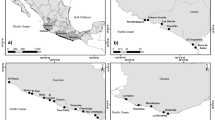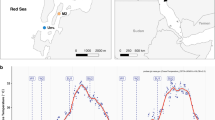Abstract
Vegetation structure, defined by the height, cover, and types of plants, is an important component of habitat suitability for plant species or communities. The identification of potential habitat is a crucial knowledge gap for endangered Atlantic Coastal Plain Flora (ACPF), a group of taxonomically unrelated plants that share common habitat types and are mostly found on lakeshores and wetlands in the Atlantic coastal region of North America. Our objectives were to assess spatial patterns and relationships of ACPF richness and structural diversity indices at different scales and positions along the lakeshore-to-forest gradient. We sampled 16 sites at 7 lakes in southwestern Nova Scotia using contiguous 20 × 20 cm quadrats along 20 m transects, perpendicular to the waterline, and in 5 × 5 m grids, between the lake and the forest edge. We measured the cover of 19 ACPF species and structural elements at different heights and calculated structural diversity indices using the Shannon index. Spatial patterns were assessed using one- and two-dimensional wavelet variance and covariance. The edge of the zone of high ACPF richness coincided with greater structural diversity at the lakeshore edge. Herbaceous ACPF richness was positively associated with structural diversity at finer scales and on lakeshores, but negatively associated at coarser scales and farther from the waterline. A strong association of structural diversity with ACPF richness suggests it could be used as a habitat indicator for ACPF on lakeshores, which could help the identification and conservation of potential suitable shorelines for ACPF populations in Nova Scotia.







Similar content being viewed by others
References
Bellamy C, Scott C, Altringham J, Minderman J (2013) Multiscale, presence-only habitat suitability models: fine-resolution maps for eight bat species. J Appl Ecol 50(4):892–901
Bradshaw GA, Spies TA (1992) Characterizing canopy gap structure in forests using wavelet analysis. J Ecol 80(2):205–215
Brosofske KD, Chen J, Crow TR, Saunders SC (1999) Vegetation responses to landscape structure at multiple scales across a Northern Wisconsin, USA, pine barrens landscape. Plant Ecol 143(2):203–218
Chen J, Franklin JF, Lowe JS (1996) Comparison of abiotic and structurally defined patch patterns in a hypothetical forest landscape. Conserv Biol 10(3):854–862
Climate Canada (2015) Temperature and precipitation chart for 1981 to 2010 Canadian Climate Normals Bridgewater. http://climate.weather.gc.ca/climate_normals/results_1981_2010_e.html?stnID=6308&lang=e&StationName=bridgewater&SearchType=Contains&stnNameSubmit=go&dCode=4&dispBack=1. Accessed Sep 2015
Crowley M, Beals L (2011) Atlantic Coastal Plain Flora in Nova Scotia; identification and information guide. Mersey Tobeatic Research Institute, Caledonia
Dale MRT (1999) Spatial pattern analysis in plant ecology. Cambridge University Press, Cambridge
Dale MRT, Mah M (1998) The use of wavelets for spatial pattern analysis in ecology. J Veg Sci 9(6):805–814
Day RT, Keddy PA, McNeill J, Carleton T (1988) Fertility and disturbance gradients: a summary model for riverine marsh vegetation. Ecology 69(4):1044–1054
Dazé Querry N, Bordeleau X, Harper KA, Basquill SP (2017) Multi-scale habitat characterization of herbaceous Atlantic Coastal Plain Flora on lakeshores in Nova Scotia. Botany 95:587–598. https://doi.org/10.1139/cjb-2016-0267
Dodonov P (2015) Assessment of edge influence in heterogeneous vegetation with a spatial pattern approach. PhD Thesis, Federal University of Sao Carlos
Edwards TC, Cutler DR, Zimmermann NE, Geiser L, Alegria J (2005) Model-based stratifications for enhancing the detection of rare ecological events. Ecology 86(5):1081–1090
Elith J, Graham CH, Anderson RP, Dudík M, Ferrier S, Guisan A, Hijmans RJ, Huettmann F, Leathwick JR, Lehmann A, Li J, Lohmann LG, Loiselle BA, Manion G, Moritz C, Nakamura M, Nakazawa Y, Overton JMcC, Peterson AT, Phillips SJ, Richardson KS, Scachetti-Pereira R, Schapire RE, Soberón J, Williams S, Wisz MS, Zimmermann NE (2006) Novel methods improve prediction of species’ distributions from occurrence data. Ecography 29:129–151
Environment Canada and Parks Canada Agency (2010) Recovery strategy and management plan for multiple species of Atlantic Coastal Plain Flora in Canada. Species at Risk Act recovery strategy series. Environment Canada and Parks Canada Agency, Ottawa
Environment Canada and Parks Canada Agency (2015) Amended recovery strategy and management plan for multiple species of Atlantic Coastal Plain Flora in Canada [Proposed]. Species at Risk Act recovery strategy series. Environment Canada and Parks Canada Agency, Ottawa
Fetherston KL, Naiman RJ, Bilby RE (1995) Large woody debris, physical process, and riparian forest development in montane river networks of the Pacific Northwest. Geomorphology 13:133–144
Francis G, Munro N (1994) A biosphere reserve for Atlantic Coastal Plain Flora, southwestern Nova Scotia. Biol Conserv 68:275–279
Fraver S (1994) Vegetation responses along edge-to-interior gradients in the mixed hardwood forests of the Roanoke River Basin, North Carolina. Conserv Biol 8(3):822–832
Grime JP (1977) Evidence for the existence of three primary strategies in plants and its relevance to ecological and evolutionary theory. Am Nat 111(982):1169–1194
Harper KA, Macdonald SE, Burton PJ, Chen J, Brosofske KD, Saunders SC, Euskirchen ES, Roberts D, Jaiteh MS, Esseen P (2005) Edge influence on forest structure and composition in fragmented landscapes. Conserv Biol 19(3):768–782
Hill NM, Keddy PA, Wisheu IC (1998) A hydrological model for predicting the effects of dams on the shoreline vegetation of lakes and reservoirs. Environ Manag 22(5):723–736
Hufkens K, Scheunders P, Ceulemans R (2009) Ecotones in vegetation ecology: methodologies and definitions revisited. Ecol Res 24:977–986
James PMA, Fleming PA (2010) Identifying significant scale-specific spatial boundaries using wavelets and null models: spruce budworm defoliation in Ontario, Canada as a case study. Landsc Ecol 25:873–887. https://doi.org/10.1007/s10980-010-9465-2
Keddy PA (1982) Quantifying within-lake gradients of wave energy: interrelationships of wave energy, substrate particle size and shoreline plants in Axe Lake, Ontario. Aquat Bot 14:41–58
Keddy PA (1985) Wave disturbance on lakeshores and the within-lake distribution of Ontario’s Atlantic Coastal Plain Flora. Can J Bot 63:656–660
Keddy PA, Reznieck AA (1982) The role of seed banks in the persistence of Ontario’s Coastal Plain Flora. Am J Bot 69(1):13–22
Kembel SW, Dale MRT (2006) Within-stand spatial structure and relation of boreal canopy and understorey vegetation. J Veg Sci 17:783–790
Komonen A (2009) Forest characteristics and their variation along the lakeshore-upland ecotone. Scand J For Res 24:515–526. https://doi.org/10.1080/02827580903280079
Magurran AE (2004) Measuring biological diversity. Blackwell Publishing, Oxford
McElhinny C, Gibbons P, Brack C, Bauhus J (2005) Forest and woodland stand structural complexity: its definition and measurement. For Ecol Manag 218:1–24. https://doi.org/10.1016/j.foreco.2005.08.034
McIntire EJB, Fajardo A (2009) Beyond description: the active and effective way to infer processes from spatial patterns. Ecology 90:46–56
Mersey Tobeatic Research Institute (2015) Database of Atlantic Coastal Plain Flora locations, habitat and habitat quality. http://www.merseytobeatic.ca/projects-freshwater-atlantic-coastal-plain-flora.php. Accessed April 2015
Moore DR, Keddy PA (1988) Effects of a water-depth gradient on the germination of lakeshore plants. Can J Bot 66:548–552
Naiman RJ, Décamps H (1997) The ecology of interfaces: riparian zones. Annu Rev Ecol Syst 28:621–658
Naiman RJ, Décamps H, Patsor J, Johnston CA (1988) The potential importance of boundaries of fluvial ecosystems. J N Am Benthol Soc 7(4):289–306
Noss RF (1990) Indicators for monitoring biodiversity: a hierarchical approach. Conserv Biol 4(4):355–364
Oksanen J, Blanchet FG, Kindt R, Legendre P, Minchin PR, O’Hara RB, Simpson GL, Solymos P, Stevens MHH, Wagner H (2015) Vegan: community ecology package. R package version 2.3-1. http://CRAN.R-project.org/package=vegan. Accessed Sep 2015
Pabst R, Spies TA (1998) Distribution of herbs and shrubs in relation to landform and canopy cover in riparian forests of coastal Oregon. Can J Bot 76:298–315
Pearce JL, Boyce MS (2006) Modelling distribution and abundance with presence-only data. J Appl Ecol 43:405–412
Ploff NL, Allan JD, Bain MB, Karr JR, Prestegaard KL, Ritcher BD, Sparks RE, Stromberg JC (1997) The natural flow regime. Bioscience 47(11):769–784
R Core Team (2015) R: a language and environment for statistical computing. R Foundation for Statistical Computing, Vienna. https://www.R-project.org/. Accessed Sep 2015
Rawinski TJ, Price SD (1994) Conclusion: an action plan for coastal plain in wetland conservation. Toward a continental conservation strategy. Biol Conserv 68:281–284
Rebelo H, Jones G (2010) Ground validation of presence-only modelling with rare species: a case study on barbastelles Barbastella barbastellus (Chrioptera: Vespetilionidae). J Appl Ecol 47:410–420
Rosenberg MS, Anderson CD (2011) PASSaGE: pattern analysis, spatial statistics, and geographic exegesis. Version 2. Methods Ecol Evol 2(3):229–232
Schneider R (1994) The role of hydrological regime in maintaining rare plant communities of New York’s coastal plain pond shores. Biol Conserv 68:253–260
Shipley B, Keddy PA, Lefkovitch LP (1991) Mechanisms producing plant zonation along a water depth gradient: a comparison with the exposure gradient. Can J Bot 69:1420–1424
Sorrie BA (1994) Coastal plain ponds in New England. Biol Conserv 68:225–233
Sweeney S, Ogilvie R (1993) The conservation of coastal plain flora in Nova Scotia. Maine Nat 1(3):131–144
Tews J, Brose U, Grimm V, Tielborger K, Wichmann MC, Schwager M, Jeltsch F (2004) Animal species diversity driven by habitat heterogeneity-diversity: the importance of keystone structure. J Biogeogr 31:79–92
Wilson SD, Keddy PA (1986) Species competitive ability and position along a natural stress/disturbance gradient. Ecology 67(5):1236–1242
Wisheu IC, Keddy PA (1989) The conservation and management of a threatened coastal plain plant community in eastern North America (Nova Scotia, Canada). Biol Conserv 48:229–238
Wisheu IC, Keddy CJ, Keddy PA, Hill NM (1994) Disjunct Atlantic Coastal Plain Species in Nova Scotia: distribution, habitat and conservation priorities. Biol Conserv 68:217–224
Acknowledgements
We would like to thank Alain Belliveau for recommending potential study species, lakes, and sites; Amanda Ring and Brittany Gerhardt for helping to collect data; and Sean Basquill, Philip Giles, and Yolanda Wiersma for providing suggestions on the manuscript. Funding was provided by the Natural Sciences and Engineering Research Council of Canada, Saint Mary’s University, Dalhousie University Biology Department, and the Government of Nova Scotia Labour and Advanced Education: Cooperative Education Incentive.
Author information
Authors and Affiliations
Corresponding author
Additional information
Communicated by Neal J. Enright.
Rights and permissions
About this article
Cite this article
Dazé Querry, N., Harper, K.A. Structural diversity as a habitat indicator for endangered lakeshore flora using an assemblage of common plant species in Atlantic Canada. Plant Ecol 218, 1339–1353 (2017). https://doi.org/10.1007/s11258-017-0772-4
Received:
Accepted:
Published:
Issue Date:
DOI: https://doi.org/10.1007/s11258-017-0772-4




